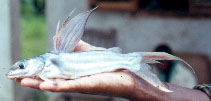| Family: |
Claroteidae (Claroteid catfishes), subfamily: Claroteinae |
| Max. size: |
31.2 cm SL (male/unsexed) |
| Environment: |
demersal; freshwater, |
| Distribution: |
Africa: endemic to the Sanaga River in Cameroon (Ref. 81642). |
| Diagnosis: |
Dorsal spines (total): 2-2; Dorsal soft rays (total): 6. Diagnosis: width (as percentage of length) of occipital process 75-114% (average 93%); depth (as percentage of width) of premaxillary tooth plate 19-36% (average 26%); vomerine teeth absent or exceptionally present as isolated teeth (mature males have a small vomerine tooth plate), palatine teeth absent (Ref. 81642).
Description: within the subgenus Chrysobagrus, C. longidorsalis has an acute, pointed snout and a relatively small mouth with premaxillary toothband 14-20% (generally 16.6%) HL; occipital process very broad (base length 5-7.5 times in HL); in 60% of specimens examined vomerine dentition was lacking, and in remaining 40% it was represented only by a few isolated teeth; palatine dentition always lacking; species, as its name suggests, also characterized by its high dorsal fin (33-66% SL) and long caudal fin (upper lobe 30-70% SL); remarkably, C. nigrodigitatus of the same locality (middle Sanaga and Nachtigal Falls) show a similar phenotype; anal fin with 4 soft branched rays and 8-9 unbranched rays; the single ripe male examined differs little from immature males but its vomerine dentition is far more developed and is in the form of a small tooth plate (Ref. 81642).
Coloration: rather uniform; in preservation head and dorsum dark brown, ventrum creamy white (Ref. 81642). |
| Biology: |
|
| IUCN Red List Status: |
Vulnerable (VU); Date assessed: 16 February 2009 (B2ab(iii)) Ref. (130435)
|
| Threat to humans: |
harmless |
| Country info: |
|
Source and more info: www.fishbase.org. For personal, classroom, and other internal use only. Not for publication.

